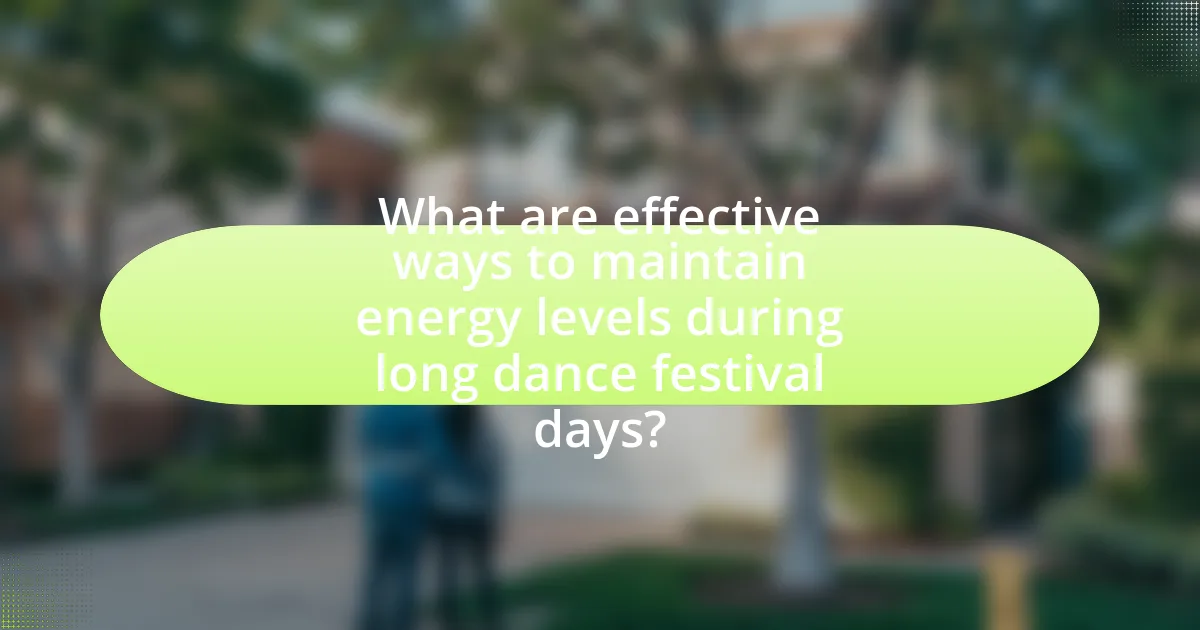The article focuses on effective strategies for staying hydrated and energized during long dance festival days. It emphasizes the importance of consistent water intake and electrolyte-rich beverages to enhance physical performance and prevent dehydration-related issues. Key signs of dehydration, such as increased thirst and fatigue, are outlined, along with the potential health consequences of neglecting hydration. The article also discusses the best types of fluids for hydration, the role of nutrition in maintaining energy levels, and practical tips for managing hydration and energy throughout the festival. Additionally, it highlights the significance of meal timing and the impact of hydration on overall performance.

How can you effectively stay hydrated during long dance festival days?
To effectively stay hydrated during long dance festival days, consistently drink water and electrolyte-rich beverages throughout the event. Research indicates that maintaining hydration levels can enhance physical performance and prevent fatigue, with the American Council on Exercise recommending 17-20 ounces of water two hours before physical activity and 8 ounces every 20 minutes during the activity. Additionally, incorporating electrolyte drinks can help replenish lost minerals due to sweating, which is crucial for sustaining energy levels and preventing dehydration-related issues.
What are the signs of dehydration to watch for while dancing?
Signs of dehydration to watch for while dancing include increased thirst, dry mouth, fatigue, dizziness, and dark yellow urine. Increased thirst indicates the body’s need for fluids, while a dry mouth suggests insufficient hydration. Fatigue and dizziness can occur due to reduced blood volume affecting energy levels and balance. Dark yellow urine is a clear indicator of concentrated waste, signaling dehydration. Recognizing these signs is crucial for maintaining performance and health during dance activities.
How can you recognize early symptoms of dehydration?
Early symptoms of dehydration can be recognized by signs such as increased thirst, dry mouth, fatigue, and dark yellow urine. These indicators suggest that the body is losing more fluids than it is taking in. Research indicates that even mild dehydration can lead to decreased physical performance and cognitive function, making it crucial to monitor these symptoms during activities like dance festivals.
What are the potential consequences of dehydration during a festival?
Dehydration during a festival can lead to serious health consequences, including heat exhaustion, heat stroke, and impaired cognitive function. Heat exhaustion occurs when the body loses excessive fluids and electrolytes, leading to symptoms such as weakness, dizziness, and nausea. If left untreated, it can escalate to heat stroke, a life-threatening condition characterized by a body temperature exceeding 104°F, confusion, and loss of consciousness. Additionally, dehydration can impair cognitive function, affecting decision-making and coordination, which is particularly dangerous in a crowded festival environment. According to the Centers for Disease Control and Prevention, dehydration can also increase the risk of kidney stones and urinary tract infections, further complicating health during high-energy events.
What types of fluids are best for hydration during dance festivals?
Water and electrolyte-rich beverages are the best fluids for hydration during dance festivals. Water is essential for maintaining hydration levels, especially in high-energy environments where sweating is prevalent. Electrolyte drinks, such as sports drinks or coconut water, help replenish lost minerals like sodium and potassium, which are crucial for muscle function and overall hydration. Research indicates that consuming fluids with electrolytes can enhance hydration efficiency, particularly during prolonged physical activity, making them ideal for the demands of dance festivals.
How do water and electrolyte drinks compare for hydration?
Water provides basic hydration, while electrolyte drinks enhance hydration by replenishing essential minerals lost through sweat. Research indicates that during prolonged physical activity, such as dancing at festivals, electrolyte drinks can improve fluid retention and hydration status more effectively than water alone. A study published in the Journal of the International Society of Sports Nutrition found that participants who consumed electrolyte beverages experienced better hydration levels compared to those who only drank water, particularly in hot conditions. This is due to the presence of sodium and other electrolytes that help maintain fluid balance in the body.
What role do caffeinated beverages play in hydration?
Caffeinated beverages can contribute to hydration, but their diuretic effect may counteract this benefit. Research indicates that moderate caffeine consumption does not lead to significant dehydration; for instance, a study published in the Journal of Applied Physiology found that caffeine intake in moderate amounts (up to 400 mg) does not negatively impact hydration status. Therefore, while caffeinated drinks can provide some hydration, they should be consumed alongside water to ensure adequate fluid intake during long dance festival days.
How often should you drink water during a dance festival?
You should drink water every 15 to 30 minutes during a dance festival. This frequency helps maintain hydration levels, especially in hot and crowded environments where sweating is common. The Institute of Medicine recommends that adults consume about 3.7 liters of total water daily for men and 2.7 liters for women, which includes fluids from beverages and food. Regular water intake during physical activity, such as dancing, is crucial to prevent dehydration and maintain energy levels.
What strategies can help you remember to stay hydrated?
To remember to stay hydrated, set specific reminders throughout the day. Utilizing smartphone alarms or hydration apps can effectively prompt you to drink water at regular intervals. Research indicates that consistent reminders can increase water intake by up to 30%, making it a practical strategy for maintaining hydration levels during long activities, such as dance festivals. Additionally, carrying a reusable water bottle can serve as a visual cue, reinforcing the habit of drinking water frequently.
How can you adjust your fluid intake based on activity levels?
To adjust fluid intake based on activity levels, increase hydration during periods of higher physical exertion and decrease it during rest periods. For example, during intense dance sessions, individuals should aim to consume 16-24 ounces of water for every hour of activity to replace fluids lost through sweat. Research indicates that even mild dehydration can impair performance, so monitoring fluid loss and adjusting intake accordingly is crucial for maintaining energy levels and overall hydration.

What are effective ways to maintain energy levels during long dance festival days?
To maintain energy levels during long dance festival days, individuals should prioritize hydration, balanced nutrition, and regular breaks. Hydration is crucial; studies show that even mild dehydration can lead to fatigue and decreased performance. Consuming water and electrolyte-rich beverages helps sustain energy. Balanced nutrition, including complex carbohydrates, proteins, and healthy fats, provides the necessary fuel. For instance, whole grains, fruits, and nuts can offer sustained energy release. Additionally, taking regular breaks to rest and stretch prevents fatigue and enhances overall stamina. These strategies are supported by research indicating that proper hydration and nutrition significantly impact physical performance and endurance.
What types of foods provide sustained energy for dancers?
Complex carbohydrates, healthy fats, and lean proteins provide sustained energy for dancers. Foods such as whole grains, fruits, vegetables, nuts, seeds, and lean meats release energy gradually, helping maintain stamina during long dance sessions. For instance, whole grain pasta and brown rice are rich in complex carbohydrates, which are digested slowly, providing a steady energy supply. Additionally, nuts and avocados contain healthy fats that support prolonged energy levels. Research indicates that a balanced intake of these food types can enhance performance and endurance in physically demanding activities like dance.
How do carbohydrates, proteins, and fats contribute to energy levels?
Carbohydrates, proteins, and fats each play distinct roles in contributing to energy levels. Carbohydrates are the body’s primary energy source, providing quick energy through glucose, which is essential for high-intensity activities like dancing. For instance, consuming complex carbohydrates, such as whole grains, can sustain energy levels over longer periods due to their gradual digestion and absorption.
Proteins contribute to energy levels by serving as a secondary energy source when carbohydrates are depleted. They are crucial for muscle repair and recovery, which is vital during physically demanding activities. For example, consuming protein-rich foods like lean meats or legumes can help maintain muscle function and energy during extended dance sessions.
Fats provide a concentrated source of energy, offering more than double the energy per gram compared to carbohydrates and proteins. They are particularly important for prolonged, lower-intensity activities, as they are metabolized slowly, providing sustained energy. Healthy fats, such as those found in avocados and nuts, can support endurance during long dance festival days.
In summary, carbohydrates offer immediate energy, proteins support muscle recovery and serve as an alternative energy source, while fats provide long-lasting energy, all of which are essential for maintaining energy levels during extended physical activities like dance festivals.
What are some quick snack options to keep your energy up?
Quick snack options to keep your energy up include nuts, yogurt, fruit, and energy bars. Nuts provide healthy fats and protein, which can sustain energy levels; for example, a handful of almonds contains about 6 grams of protein and 14 grams of fat, making them a nutrient-dense choice. Yogurt, particularly Greek yogurt, is rich in protein and probiotics, aiding digestion and energy maintenance. Fresh fruits like bananas and apples offer quick carbohydrates and essential vitamins; a medium banana contains approximately 27 grams of carbohydrates, providing a rapid energy boost. Energy bars, especially those with whole ingredients, can deliver a balanced mix of carbohydrates, protein, and fats, making them convenient for on-the-go snacking.
How can you manage your energy levels throughout the day?
To manage your energy levels throughout the day, prioritize hydration, balanced nutrition, and regular movement. Staying hydrated is crucial, as even mild dehydration can lead to fatigue; research indicates that a 2% loss in body weight due to dehydration can impair physical performance and cognitive function. Consuming balanced meals that include complex carbohydrates, proteins, and healthy fats provides sustained energy, while snacks like fruits and nuts can help maintain energy levels between meals. Additionally, incorporating short breaks for movement or stretching can enhance circulation and reduce fatigue, as physical activity stimulates energy production in the body.
What role does pacing play in maintaining energy during performances?
Pacing is crucial for maintaining energy during performances as it helps regulate physical exertion and prevents fatigue. By strategically managing the intensity and duration of movements, performers can sustain their energy levels throughout the event. Research indicates that pacing allows dancers to optimize their performance by balancing high-energy sequences with periods of lower intensity, which aids in recovery and energy conservation. For instance, a study published in the Journal of Sports Sciences found that athletes who employed effective pacing strategies experienced less fatigue and improved overall performance compared to those who did not. This demonstrates that proper pacing is essential for sustaining energy and enhancing performance quality during long dance festival days.
How can rest periods help recharge your energy?
Rest periods can significantly recharge your energy by allowing the body to recover and restore its physical and mental resources. During periods of activity, such as dancing, the body depletes energy reserves and experiences fatigue. Research indicates that short breaks can enhance performance and reduce exhaustion by promoting muscle recovery and mental clarity. For instance, a study published in the Journal of Sports Sciences found that athletes who incorporated rest intervals performed better and reported lower levels of fatigue compared to those who did not take breaks. This evidence supports the idea that strategic rest periods are essential for maintaining energy levels during prolonged activities like dance festivals.
What are the best practices for meal timing during a festival?
The best practices for meal timing during a festival include eating balanced meals at regular intervals to maintain energy levels. Consuming a substantial meal before the festival starts ensures a good energy reserve, while smaller, nutrient-dense snacks throughout the day help sustain energy without causing fatigue. Research indicates that eating every 3-4 hours can optimize energy levels and prevent crashes, which is crucial during long dance festival days. Additionally, timing meals around peak activity periods can enhance performance and enjoyment, as proper nutrition supports stamina and hydration.
How can you plan meals around your dance schedule?
To plan meals around your dance schedule, prioritize timing and nutrient density to support energy levels. Schedule meals and snacks around dance classes and performances, ensuring to eat a balanced meal 2-3 hours before dancing for optimal energy. Include carbohydrates for quick energy, proteins for muscle repair, and healthy fats for sustained energy. For instance, a meal of whole grain pasta with lean protein and vegetables can provide the necessary fuel. Additionally, incorporate snacks like fruits, nuts, or yogurt between sessions to maintain energy levels. Research indicates that proper meal timing and composition can enhance performance and recovery in athletes, including dancers.
What should you eat before, during, and after dancing?
Before dancing, consume complex carbohydrates such as whole grain bread or oatmeal to provide sustained energy. These foods release glucose gradually, which is essential for maintaining energy levels during physical activity. During dancing, snack on easily digestible carbohydrates like bananas or energy bars to replenish energy quickly without causing digestive discomfort. After dancing, prioritize protein and carbohydrates, such as a smoothie with protein powder and fruit or a chicken salad, to aid muscle recovery and restore glycogen levels. Research indicates that consuming a combination of protein and carbohydrates post-exercise enhances recovery and muscle synthesis, making these food choices effective for dancers.

How can you combine hydration and energy strategies for optimal performance?
To combine hydration and energy strategies for optimal performance, individuals should consume electrolyte-rich fluids alongside carbohydrate-based snacks. This approach ensures that the body maintains fluid balance while providing the necessary energy for sustained activity. Research indicates that beverages containing electrolytes, such as sodium and potassium, enhance hydration efficiency, while carbohydrates replenish glycogen stores, crucial for endurance activities. For instance, a study published in the Journal of Sports Sciences found that athletes who consumed a combination of electrolytes and carbohydrates performed better in prolonged physical activities compared to those who only focused on hydration or energy intake separately.
What are the key factors to consider for hydration and energy synergy?
The key factors to consider for hydration and energy synergy include fluid balance, electrolyte replenishment, and carbohydrate intake. Maintaining fluid balance is crucial, as dehydration can lead to decreased performance and fatigue; studies show that even a 2% loss in body weight due to fluid loss can impair physical performance. Electrolyte replenishment, particularly sodium and potassium, is essential to prevent muscle cramps and maintain nerve function, especially during prolonged physical activity. Additionally, carbohydrate intake provides the necessary energy for sustained activity; research indicates that consuming carbohydrates during exercise can enhance endurance and delay fatigue.
How does hydration impact your energy levels while dancing?
Hydration significantly impacts energy levels while dancing by maintaining optimal physiological function. When the body is adequately hydrated, it can efficiently regulate temperature, transport nutrients, and remove waste, all of which are crucial for sustained energy during physical activity. Research indicates that even mild dehydration can lead to fatigue, decreased coordination, and impaired cognitive function, which can hinder performance on the dance floor. For instance, a study published in the Journal of Athletic Training found that a loss of just 2% of body weight due to dehydration can negatively affect endurance and strength. Therefore, staying hydrated is essential for maximizing energy levels and overall performance while dancing.
What are the best hydration practices to support energy maintenance?
The best hydration practices to support energy maintenance include drinking water consistently throughout the day, consuming electrolyte-rich beverages, and monitoring urine color for hydration status. Regular water intake helps maintain blood volume and regulates body temperature, which is crucial during physical activities like dancing. Electrolyte beverages, such as sports drinks or coconut water, replenish essential minerals lost through sweat, aiding in muscle function and preventing fatigue. Additionally, a light yellow urine color indicates proper hydration, while darker urine suggests a need for increased fluid intake. These practices ensure optimal hydration levels, thereby supporting sustained energy during long dance festival days.
What practical tips can help you stay hydrated and energized during festivals?
To stay hydrated and energized during festivals, consistently drink water and consume electrolyte-rich foods. Hydration is crucial as it helps maintain energy levels and prevents fatigue, especially in hot environments where dehydration can occur rapidly. Studies show that even mild dehydration can impair physical performance and cognitive function, making it essential to drink water regularly, aiming for at least 2-3 liters per day. Additionally, incorporating snacks like bananas, nuts, and sports drinks can replenish electrolytes lost through sweat, further supporting energy levels.
How can you create a hydration and energy plan for a dance festival?
To create a hydration and energy plan for a dance festival, prioritize water intake and balanced nutrition throughout the event. Begin by calculating the daily water requirement, which is typically around 2 to 3 liters for active individuals, and ensure easy access to water stations. Incorporate electrolyte-rich beverages to replenish lost minerals due to sweating. For energy, plan meals and snacks that include complex carbohydrates, proteins, and healthy fats, such as whole grains, fruits, nuts, and lean proteins, to sustain energy levels. Research indicates that maintaining hydration and balanced nutrition can enhance performance and endurance, as dehydration can lead to fatigue and decreased cognitive function.
What common mistakes should you avoid to maintain hydration and energy?
To maintain hydration and energy, avoid the common mistake of relying solely on caffeinated beverages, as they can lead to dehydration. Additionally, neglecting to drink water regularly throughout the day can result in fatigue and decreased performance. Skipping meals or consuming high-sugar snacks instead of balanced meals can also diminish energy levels. Research indicates that proper hydration improves cognitive function and physical performance, highlighting the importance of consistent water intake and nutritious food choices during long dance festival days.
